Physical Address
304 North Cardinal St.
Dorchester Center, MA 02124
Carpometacarpal (CMC) joint arthroplasty with trapeziectomy with or without ligament reconstruction provides predictable pain relief for most patients. Revision CMC arthroplasty is indicated in patients with persistent or recurrent basilar thumb pain or instability who are at least 1 year out from their primary procedure and have failed symptomatic management.
Patients must be counseled that revision procedures are less predictable than primary CMC arthroplasty. Multiple surgeries are sometimes necessary. The primary goal of revision surgery is pain relief; functional improvement is secondary.
A successful revision CMC arthroplasty depends on identification of the source of pain. Common reasons for failure include subsidence of the first metacarpal with bony impingement on the scaphoid or trapezoid, untreated or progressive scaphotrapezoidal (ST) arthritis, superficial sensory radial nerve (SSRN) neuroma, untreated metacarpophalangeal (MCP) joint laxity or arthritis, and unrecognized concomitant pathology (carpal tunnel syndrome or tendinopathy). Treatment must be tailored to the reason for failure.
Subsidence of the thumb metacarpal after primary arthroplasty is common and not usually functionally significant. Not all patients with collapse deformities require revision surgery; many patients will adapt or compensate. Revision surgery is indicated for intolerable pain or instability.
Revision CMC arthroplasty requires thoughtful planning. The surgical treatment plan must address each source of pain ( Table 48.1 ).
| Cause of Symptoms | Suggested Treatment |
|---|---|
| Subsidence of thumb metacarpal | Revision basilar joint arthroplasty or thumb-index metacarpal arthrodesis (salvage) |
| MCP joint instability or arthritis | MCP joint capsuloplasty or arthrodesis |
| Superficial sensory radial nerve injury | Neurolysis or excision of neuroma and nerve grafting |
| Scaphotrapezoidal arthritis | Proximal hemi-trapezoidectomy |
| Second CMC joint arthritis | Distal hemi-trapezoidectomy |
| Carpal tunnel syndrome | Carpal tunnel release |
| De Quervain tenovaginitis | First dorsal compartment release |
| FCR tendonitis | Debridement or tenotomy |
| Complex regional pain syndrome | Referral to pain management |
There are a few critical questions to ask:
What is the cause of recurrent symptoms (mechanical pain, neuropathic pain, instability)?
What surgery has been performed?
What options are available?
The goals of revision CMC arthroplasty are to:
Restore stability of the CMC joint
Restore length of the thumb ray
Correct hyperextension of the MCP joint
Address MCP, ST, and second CMC (index metacarpal-trapezoid) joint arthritis
Treat neuropathic pain
Treat concomitant carpal tunnel syndrome or tendinopathies
There are many options to restore thumb length and stability, including revision arthroplasty with a different tendon or technique, and suspensionplasty with suture tape, endo-buttons, bone anchors, or tenodesis screws. Our preferred technique is to create a sling under the base of the thumb metacarpal using a slip of abductor pollicis longus (APL) and suture tape. Thumb-to-index metacarpal arthrodesis is considered when soft tissue suspension techniques are exhausted.
The thumb CMC joint is assessed for range of motion (ROM), stability, function, and pain. Pain with axial loading suggests symptomatic metacarpal subsidence with bony impingement on the trapezoid or scaphoid. Patients with ST arthritis have pain in the anatomic snuff box. Areas of hypersensitivity, burning pain, a Tinel sign along the scar, or pain proximal to the CMC joint may indicate a SSRN neuroma or nerve entrapment in scar.
The MCP joint is assessed for posture, ROM, stability, and pain. Compensatory MCP joint hyperextension is common in patients with CMC arthritis and is easily identified with tip-to-tip pinch. MCP joint osteoarthritis develops over time and contributes to patient dissatisfaction after basilar joint surgery.
Objective measurements should include radial/palmar abduction and active/passive MCP joint motion. Key pinch should be recorded and compared with preoperative values and the opposite hand.
Many patients have concomitant carpal tunnel syndrome or tendinopathy. Patients must be evaluated for numbness, palmar pain, triggering on interphalangeal (IP) joint flexion, and pain along the first dorsal compartment, flexor carpi radialis (FCR) tendon, or A1 pulley. These conditions contribute to pain at the base of the thumb and should be treated at the time of revision CMC surgery.
Standard anteroposterior (AP), lateral, and oblique radiographs of the hand are used to evaluate the bony anatomy. The location of the thumb metacarpal base and any impingement on the scaphoid or trapezoid is noted. Residual trapezium and other osteophytes are identified. The ST joint is carefully evaluated because unrecognized or progressive ST arthritis can cause ongoing pain. The MCP joint is also evaluated for arthritis and hyperextension ( Fig. 48.1 ).
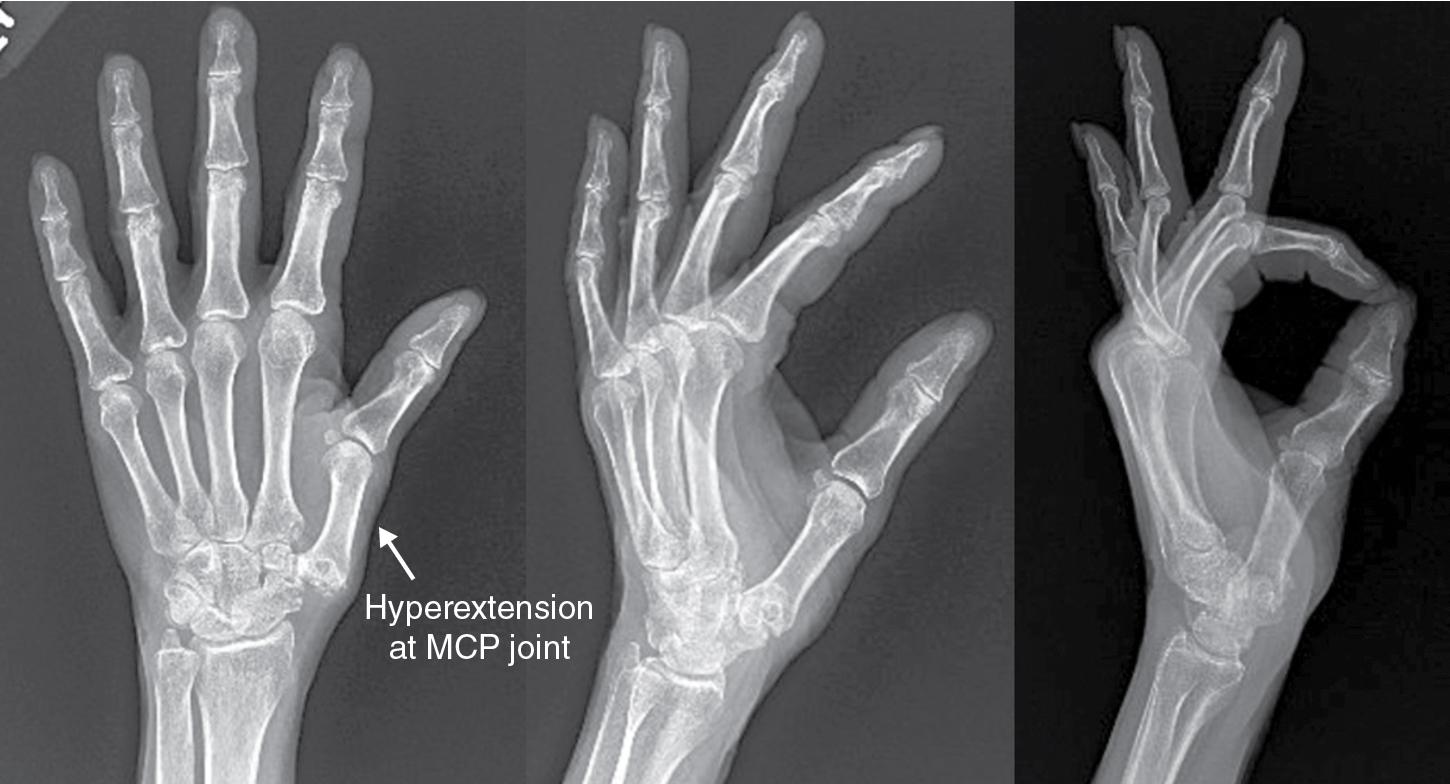
Image-guided injection of local anesthetic with steroid into the ST or second CMC joint can be helpful to localize the source of the pain.
Ultrasound is considered if the patient complains of burning or electrical-type pain proximal to the CMC joint or has a Tinel sign on examination. Ultrasound-guided anesthetic injection of SSRN neuromas can confirm the diagnosis.
After trapeziectomy, the thumb metacarpal may subluxate dorsally and subside proximally ( Fig. 48.2 ).
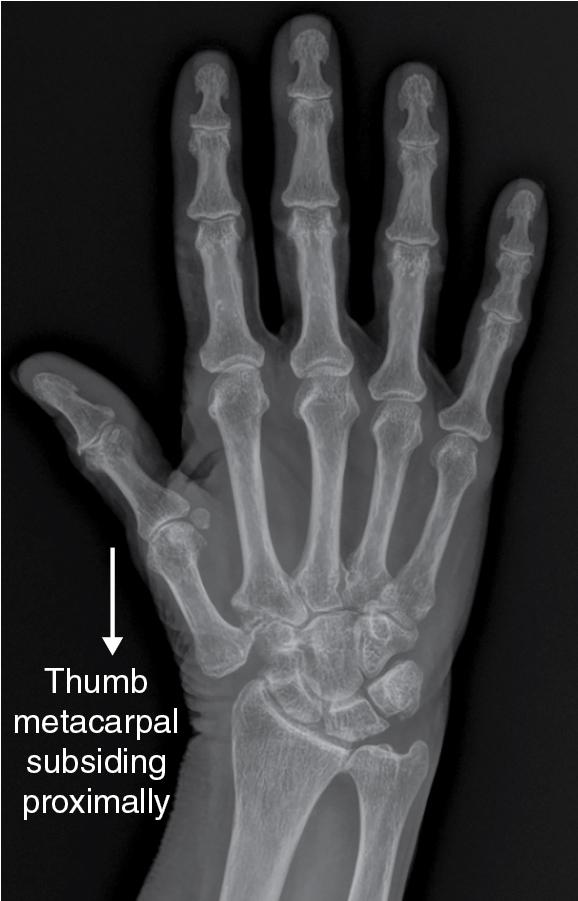
The CMC joint flexes and adducts because of forces from the flexor pollicis longus (FPL) and thenar intrinsics.
The moment arms that affect the MCP joint with pinch increasingly favor extension. The IP joint develops extensor lag because of MCP joint hyperextension.
Proximal subsidence of the thumb metacarpal may result in metacarpal impinging onto the scaphoid ( Fig. 48.3 ) or trapezoid.
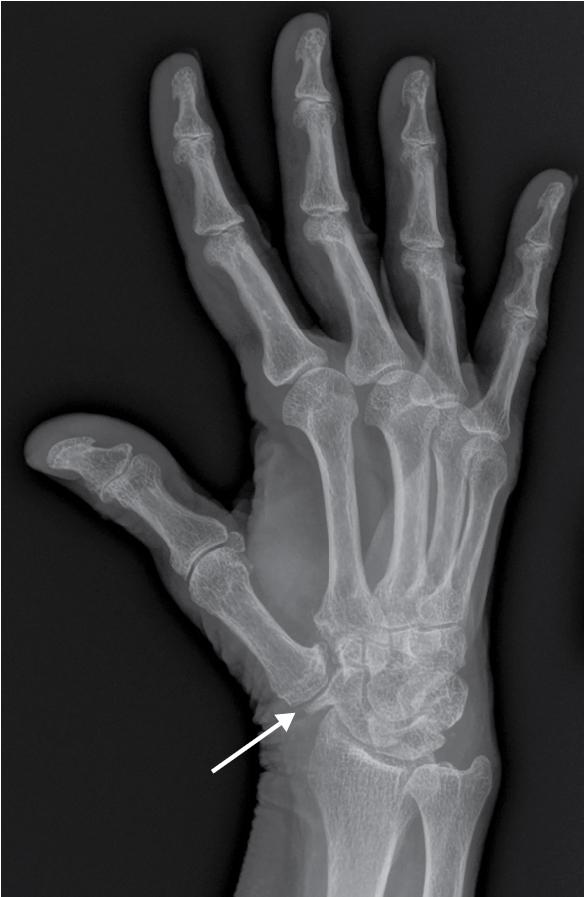
With progressive CMC collapse, there is loss of length of the thumb ray; loss of extension, abduction, and opposition; loss of strength; and sometimes pain.
The patient is positioned supine on the operating room table with a hand table extension.
A tourniquet and fluoroscopy are required.
Depending on the technique used, Kirschner wires (K-wires) and a wire driver, headless compression screws, low-profile plates and screws, bone anchors, and/or tenodesis screws and suture tape may be necessary.
An indication for this procedure is failed primary CMC arthroplasty with symptomatic first metacarpal subsidence.
A contraindication is attenuation or scarring of the APL tendon from use in previous surgery.
The previous incision is used if possible and extended as needed. If this does not provide adequate exposure, a 4-cm longitudinal skin incision is designed over the base of the thumb metacarpal midway between the APL and EPL tendons ( Fig. 48.4 ).
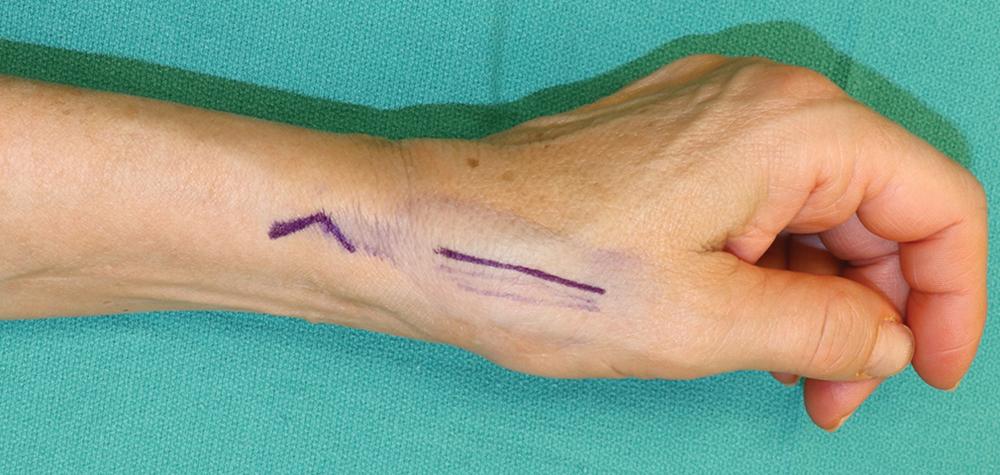
A chevron incision over the first dorsal compartment at the level of the radial styloid allows access to the APL tendon proximally.
The skin is incised sharply, then blunt dissection is used to expose the joint capsule ( Fig. 48.5 ). Branches of the SSRN and the dorsal branch of the radial artery are identified and protected.
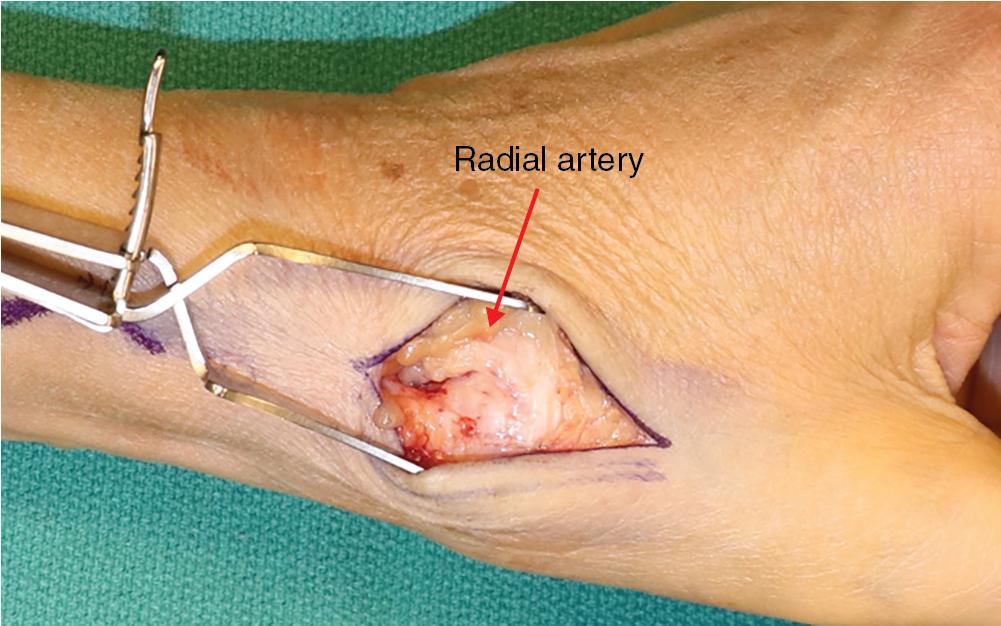
The joint capsule is incised longitudinally, and the base of the thumb metacarpal is exposed ( Fig. 48.6 ).
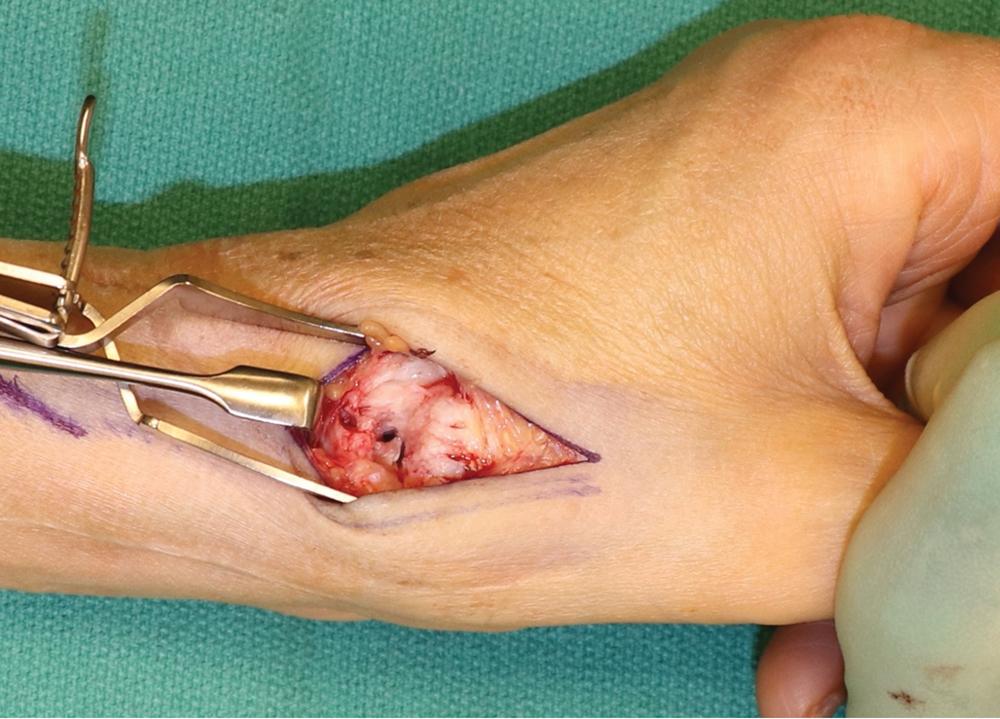
Scar, synovitis, and osteophytes are debrided from the arthroplasty space with a rongeur. Any hardware is removed and soft tissue reconstructions from previous surgeries are taken down.
If nerve injury is suspected from a previous surgery, SSRN branches are carefully explored. Neurolysis is sufficient if nerve branches are intact but trapped in scar. Neuromas are buried proximally into a muscle.
SSRN nerve branches can be difficult to identify in scarred tissue planes. Dissection should proceed with caution. If nerve injury is identified at the time of surgery, repair is performed.
Become a Clinical Tree membership for Full access and enjoy Unlimited articles
If you are a member. Log in here